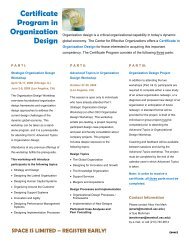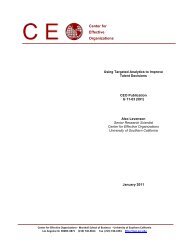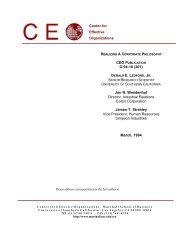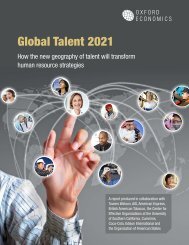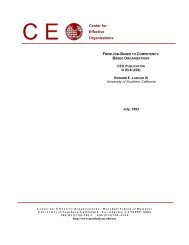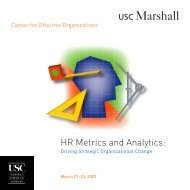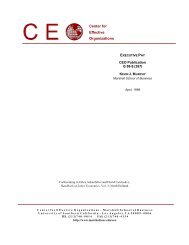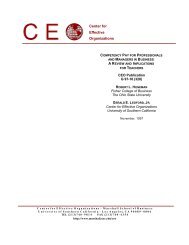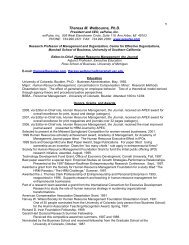Our Past, Present, and Future in Teams - Center for Effective ...
Our Past, Present, and Future in Teams - Center for Effective ...
Our Past, Present, and Future in Teams - Center for Effective ...
Create successful ePaper yourself
Turn your PDF publications into a flip-book with our unique Google optimized e-Paper software.
2The majority of Fortune 1000 employees have been affected by the widespread proliferation of work teams.This holds true also <strong>for</strong> the millions of employees <strong>and</strong> managers who work outside the Fortune 1000. Recentevidence about the growth <strong>in</strong> work teams re<strong>in</strong><strong>for</strong>ces the notion that teams have become a way of life <strong>in</strong> manyorganizations (Osterman, 1994; Lawler, Mohrman, & Led<strong>for</strong>d, 1995). For example, Osterman (1994) found that over 50percent of the 700 firms he studied were us<strong>in</strong>g teams <strong>and</strong> that over 40 percent had more than half of their employeeswork<strong>in</strong>g <strong>in</strong> teams. With the use of teams cont<strong>in</strong>u<strong>in</strong>g to grow, human resources professionals need more knowledgeabout teams <strong>in</strong> general <strong>and</strong>, more specifically, <strong>in</strong><strong>for</strong>mation about the human resources practices that enhance teamper<strong>for</strong>mance. Human resources are critical <strong>for</strong> the development <strong>and</strong> implementation of organizational strategies <strong>and</strong>structures. Successful HR professionals will be those who can align their organizational HR practices with theunique dem<strong>and</strong>s of team-based organizational structures.In this chapter, we have four objectives. First, we provide human resource professionals with a brief historyabout the use of teams <strong>in</strong> the United States. We review def<strong>in</strong>itions <strong>and</strong> types of teams, evidence regard<strong>in</strong>g theimpact of teams, <strong>and</strong> the factors which led to the proliferation of teams. Second, we aim to provide the humanresource professional with tools to <strong>in</strong>crease the effectiveness of teams. We discuss the key assumptions that mustbe adapted to create supportive conditions <strong>for</strong> teams. Third, we review modifications <strong>in</strong> human resource practicesthat are necessary to effectively implement teams. F<strong>in</strong>ally, we discuss potential challenges that human resourcepractitioners may face <strong>in</strong> implement<strong>in</strong>g teams <strong>in</strong> mult<strong>in</strong>ational organizations. Look<strong>in</strong>g to the future, we presentguidel<strong>in</strong>es <strong>for</strong> meet<strong>in</strong>g these challenges. We conclude with some predictions regard<strong>in</strong>g the prospective use of teamsthat will likely develop as our team-based organizations cont<strong>in</strong>ue to evolve.What <strong>Teams</strong> Are, Why Now, How <strong>Teams</strong> Contribute, <strong>and</strong> When to Use ThemIn general, a work team can be def<strong>in</strong>ed as a group of <strong>in</strong>dividuals work<strong>in</strong>g <strong>in</strong>terdependently to solve problemsor accomplish tasks (Manz & Sims, 1993; Sundstrom, De Meuse, & Futrell, 1990). However, a s<strong>in</strong>gle def<strong>in</strong>ition is notsufficient to capture the key differences that exist between the various types of teams be<strong>in</strong>g used <strong>in</strong> organizations.Table 1 shows the most common types of work teams <strong>and</strong> their key characteristics <strong>and</strong> differences.___________________________Insert Table 1 about here___________________________
3A number of key differences between these types of teams will determ<strong>in</strong>e the efficacy of human resourcespractices designed to enhance team effectiveness. For example, compensation structures are normally altered <strong>for</strong>self-manag<strong>in</strong>g work teams to <strong>in</strong>clude team-based rewards to encourage cooperation between team members <strong>and</strong> tomotivate members to reach team goals (Gerhart & Milkovich, 1992; Kan<strong>in</strong>-Lovers & Cameron, 1993). S<strong>in</strong>ce selfmanag<strong>in</strong>gmembers are work<strong>in</strong>g on permanent teams, the ef<strong>for</strong>t <strong>and</strong> expense <strong>in</strong>volved <strong>in</strong> chang<strong>in</strong>g compensationstructures is often times justified. However, <strong>in</strong> more temporary teams like problem solv<strong>in</strong>g or cross-functional teams,other types of human resources policy changes (<strong>for</strong> example, alter<strong>in</strong>g an evaluation system to <strong>in</strong>clude teambehaviors) may be a more appropriate strategy to encourage positive team behaviors. <strong>Our</strong> po<strong>in</strong>t here is not to reviewall of the appropriate human resources policies <strong>for</strong> each type of team (see Cohen & Bailey, 1997, <strong>for</strong> a good review),but to acknowledge that our use of the words “work team” implies several different types of teams.Contrary to popular beliefs, teams are not a “new” phenomenon. The orig<strong>in</strong>s of teams can be traced to theTavistock studies of post World War II (Trist & Bam<strong>for</strong>th, 1951) <strong>and</strong> to the Swedish socio-technical movementgenerally associated with the Volvo Corporation (Pasmore, 1995). The first work teams <strong>in</strong> the United States werefound <strong>in</strong> the Procter & Gamble Company <strong>in</strong> the early 1960s, the Topeka work system at a General Foods pet foodplant <strong>in</strong> the late 1960s (Walton, 1972), <strong>and</strong> <strong>in</strong> the Rushton Quality of Work Project <strong>in</strong> Pennsylvania <strong>in</strong> the mid-1970s(Goodman, 1979). Given that teams were identified as a mechanism <strong>for</strong> improv<strong>in</strong>g employee per<strong>for</strong>mance as early asthe 1960s, why has it taken over 30 years to implement work teams on a large scale <strong>in</strong> the United States?We attribute the recent rise <strong>in</strong> the <strong>in</strong>terest <strong>and</strong> use of work teams over the last 10 years to three factors: (1) a higherconcern <strong>for</strong> the social component of work; (2) the globalization of the U.S. economy <strong>and</strong> result<strong>in</strong>g downsiz<strong>in</strong>g; <strong>and</strong>(3) the early adoption of work teams by highly visible companies such as General Motors, AT&T, General Electric,Xerox, <strong>and</strong> Motorola. While many believe that organizations have adopted work teams to improve employee moraleor productivity, the <strong>for</strong>ces beh<strong>in</strong>d team adoption have been much larger <strong>in</strong> scale <strong>and</strong> much more connected to globalpatterns of <strong>in</strong>ternational bus<strong>in</strong>ess. Organizations have adopted work teams because many of them had no choice.Dramatically reduced numbers of managers could not keep up with employee activities on a day-to-day basis.Furthermore, the <strong>in</strong>crease <strong>in</strong> the use teams can be attributed, <strong>in</strong> part, to evidence <strong>for</strong> their success. Workteams have been associated with higher levels of productivity (Banker, Field, Schroeder, & S<strong>in</strong>ha, 1996; Cohen &Led<strong>for</strong>d, 1994); quality (Banker <strong>and</strong> others, 1996; Cohen & Led<strong>for</strong>d, 1994, Well<strong>in</strong>s <strong>and</strong> others, 1990); customer
4satisfaction (Well<strong>in</strong>s <strong>and</strong> others, 1990); safety (Cohen & Led<strong>for</strong>d, 1994); job satisfaction (Cordery, Mueller, & Smith,1991; Wall, Kemp, Jackson, & Clegg, 1986); <strong>and</strong> organizational commitment (Cordery <strong>and</strong> others, 1991). It should benoted, however, that most of these studies have been conducted with self-manag<strong>in</strong>g work teams. For traditionalwork teams, much of the evidence <strong>for</strong> impact has been collected on a case-by-case basis. Well<strong>in</strong>s, Byham, <strong>and</strong> Dixon(1990), <strong>for</strong> example, chronicle the pervasive positive impact teams have had <strong>in</strong> twenty companies. These companiesclaim that implement<strong>in</strong>g teams resulted <strong>in</strong> improvements <strong>in</strong> bottom l<strong>in</strong>e <strong>in</strong>dicators such as cost sav<strong>in</strong>gs, quality <strong>and</strong>service improvement, speed, absenteeism, <strong>and</strong> turnover.This is not to say that teams are a panacea. Several studies regard<strong>in</strong>g the impact of teams have failed to f<strong>in</strong>deffects <strong>for</strong> per<strong>for</strong>mance on more quantitative measures such as productivity (<strong>for</strong> example, see Wall <strong>and</strong> others, 1986);other studies report only modest f<strong>in</strong>d<strong>in</strong>gs <strong>for</strong> productivity (see Goodman <strong>and</strong> others, 1988). Smaller effect sizes <strong>for</strong>productivity may be due to us<strong>in</strong>g work teams <strong>in</strong> contexts where they are not appropriate. Clearly, work teams are notideal <strong>for</strong> every task (Even if you have a hammer, not every problem is a nail). Work teams are more effective under theright circumstances <strong>and</strong> situations.For example, work teams are most effective when there is high task <strong>in</strong>terdependence, or a high degree ofcoord<strong>in</strong>ation <strong>and</strong> collaboration required between team members to accomplish tasks (Shea & Guzzo, 1987). Thus,tak<strong>in</strong>g a group of <strong>in</strong>surance sales agents who are geographically dispersed <strong>and</strong> have little <strong>in</strong>teraction with each otherto carry out their tasks would most likely be an <strong>in</strong>appropriate context <strong>in</strong> which to implement teams. The agents wouldlikely see such an ef<strong>for</strong>t as an empty, poorly developed strategy designed to capitalize on a management fad.Work teams are also more appropriate when the tasks that members carry out are complex <strong>and</strong> well designed(Cordery, Wall, & Wright, 1997). If a group’s work is rout<strong>in</strong>e <strong>and</strong> unchalleng<strong>in</strong>g, of dubious importance, <strong>and</strong> whollypreprogrammed with no opportunity <strong>for</strong> feedback, teams will probably not make much difference <strong>in</strong> productivity(Hackman, 1987: 325). As Johns (1996) has stated, “Tak<strong>in</strong>g a bunch of olive stuffers on a food process<strong>in</strong>g assemblyl<strong>in</strong>e, putt<strong>in</strong>g them <strong>in</strong> dist<strong>in</strong>ctive jumpsuits, call<strong>in</strong>g them the Olive Squad, <strong>and</strong> tell<strong>in</strong>g them to self-manage will beunlikely to yield dividends <strong>in</strong> terms of ef<strong>for</strong>t expended or bra<strong>in</strong>power employed” (p. 257). Work teams, especiallythose that <strong>in</strong>crease autonomy <strong>and</strong> responsibility, are most effective when members are given complex tasks thatcapitalize on the diverse knowledge <strong>and</strong> skills of a team. Thus, teams should view their tasks as significant, the tasks
5should require the use of a variety of skills, <strong>and</strong> members should, where possible, assemble an entire product ordeliver a complete service.The effectiveness of work teams also depends on whether an organization has high <strong>in</strong>tegration needs due toits operat<strong>in</strong>g <strong>in</strong> a complex environment (Mohrman, Cohen, & Mohrman, 1995). Complex environments typically <strong>for</strong>ceorganizations to serve a wide variety of customers, deal with rapidly chang<strong>in</strong>g technology, <strong>and</strong> satisfy large numbersof different stakeholders. IBM, <strong>for</strong> example, faces a much more complex environment than McDonalds (<strong>for</strong> example,compare the rate of change of PCs versus Big Macs over the last 15 years). Organizations must simultaneously dealwith all of these issues (<strong>in</strong> other words, differentiate <strong>in</strong>to smaller more responsive units) <strong>and</strong> then <strong>in</strong>tegrate thesewidely dispersed ef<strong>for</strong>ts <strong>and</strong> units back <strong>in</strong>to one cohesive organization. <strong>Teams</strong> will be most effective when a teamstructure is the best solution to obta<strong>in</strong><strong>in</strong>g the <strong>in</strong>tegration required to accomplish goals <strong>in</strong> a complex organizationalenvironment (Mohrman <strong>and</strong> others, 1995). Without effective <strong>in</strong>tegration, the benefits attributed to work teams(<strong>in</strong>creased productivity, higher quality, better job satisfaction) will be realized.Thus, companies implement<strong>in</strong>g teams from a “b<strong>and</strong>wagon” perspective will not realize the potential benefitsto be had from an appropriate fit between teams <strong>and</strong> work context. In fact, many organizations are currentlystruggl<strong>in</strong>g with team effectiveness. We argue that this is due <strong>in</strong> part to traditional assumptions about work that stillprevail. In order to effectively implement teams, a change <strong>in</strong> assumptions must occur. We next discuss theseadaptations.Adapt<strong>in</strong>g <strong>Our</strong> AssumptionsWe discuss the assumptions that shaped the decisions made by human resources professionals <strong>in</strong>traditional hierarchical organizations <strong>in</strong> three areas: (1) motivation, (2) the structure of work; <strong>and</strong> (3) accountability.Traditional assumptions must be adapted <strong>in</strong> order to support effective implementation of teams. These adaptationsare summarized <strong>in</strong> Table 2. As we discuss each area of assumptions, we elaborate on the necessary adaptations.___________________________Insert Table 2 about here___________________________Motivation
6The first set of assumptions that must be exam<strong>in</strong>ed perta<strong>in</strong> to motivation. <strong>Our</strong> national culture helps todeterm<strong>in</strong>e what motivates us. For example, some cultures can be classified as <strong>in</strong>dividualistic, or cultures <strong>in</strong> whichpeople tend to value their own self-<strong>in</strong>terest <strong>and</strong> welfare over the <strong>in</strong>terests of groups or societies; other cultures areknown as collectivistic, or cultures <strong>in</strong> which people tend to value the welfare of groups more than their own welfare(Hofstede, 1980). Individualists are motivated by the opportunity to ga<strong>in</strong> personal recognition. They resist work<strong>in</strong>g<strong>in</strong> teams more than people from collectivistic cultures (Kirkman, 1996; Kirkman & Shapiro, 1997). Such resistancelowers team effectiveness on outcomes such as productivity, job satisfaction, cooperativeness, <strong>and</strong> organizationalcommitment (Kirkman, 1996). It will take time <strong>and</strong> experience <strong>for</strong> people to adjust their notions of fairness <strong>and</strong> equityto <strong>in</strong>clude collective accountability. Tak<strong>in</strong>g a longer term focus <strong>and</strong> underst<strong>and</strong><strong>in</strong>g the eventual payoffs <strong>for</strong> early<strong>in</strong>vestments <strong>in</strong> team-based systems is essential <strong>for</strong> harness<strong>in</strong>g the motivational power of teams.In underst<strong>and</strong><strong>in</strong>g motivational assumptions, it is also important to consider expectations. Research atteststo the importance of collective expectations <strong>in</strong> determ<strong>in</strong><strong>in</strong>g our level of motivation, <strong>and</strong> subsequently ourper<strong>for</strong>mance (B<strong>and</strong>ura, 1997; Gibson, 1995). When we believe we can accomplish objectives as a team, we aremotivated to stick with our work tasks <strong>and</strong> prevail. However, sometimes these high expectations get out of h<strong>and</strong>, tothe po<strong>in</strong>t that teams hold unrealistic expectations. Cohesive teams often fall prey to this phenomenon, which isreferred to as “groupth<strong>in</strong>k” (Janis, 1982). Co<strong>in</strong>cid<strong>in</strong>g with extremely high expectations, teams suffer<strong>in</strong>g fromgroupth<strong>in</strong>k also hold illusions of <strong>in</strong>vulnerability. Such teams ignore important external <strong>in</strong><strong>for</strong>mation sources whichmight help them adjust their per<strong>for</strong>mance to better fit the needs of customers. Individualistic teams appear to beparticularly susceptible to over confidence (Gibson, 1996). This may be because <strong>in</strong>dividualists view their team as anentity <strong>in</strong> <strong>and</strong> of itself, rather than connected to the external context, <strong>and</strong> are there<strong>for</strong>e even less apt to utilize externalsources of <strong>in</strong><strong>for</strong>mation to make corrections <strong>in</strong> their behavior <strong>and</strong> improve their per<strong>for</strong>mance. Particularly <strong>in</strong><strong>in</strong>dividualistic cultures, team-based organizations need to have systems that help teams set realistic expectations.This allows teams to stay motivated, while at the same time open to learn<strong>in</strong>g from feedback <strong>and</strong> mistakes.Work StructureBeyond motivation, a second doma<strong>in</strong> of assumptions concerns the structure of work. Traditional workgroups were generally <strong>for</strong>med around common technical or functional skills <strong>and</strong> areas of expertise (<strong>for</strong> example,account<strong>in</strong>g, f<strong>in</strong>ance, or production). In recent years, it has become apparent that organiz<strong>in</strong>g work around a process
7(<strong>for</strong> example, new product development), rather than around a specific task or function is more effective (Dunphy &Bryant, 1996). Do<strong>in</strong>g so often requires extend<strong>in</strong>g team members' task skills. Multiskilled teamwork <strong>in</strong>volves teamsmade up of <strong>in</strong>dividuals with multiple <strong>and</strong> overlapp<strong>in</strong>g skills that are deployed around the per<strong>for</strong>mance of a whole taskwhich represents a significant part of a larger work flow. Members are multiskilled so that work can be flexiblyallocated among them.In organiz<strong>in</strong>g work around processes, organizational boundaries must often be re-negotiated. Increas<strong>in</strong>gly,work teams have external customers <strong>and</strong> suppliers as members. For example, General Electric Medical Systems <strong>in</strong>vitesrepresentatives from lead<strong>in</strong>g HMO’s to serve on their sales <strong>and</strong> service teams. The American Red Cross hasmembers of the communities serv<strong>in</strong>g on key committees that set organizational objectives. Eastman Kodak alliesitself with key competitors to <strong>for</strong>m market segment task <strong>for</strong>ces. These types of work structures require a whole newnotion of collaboration - collaboration with external constituencies. Those who were previously viewed as “them”are now viewed as “us.”The re-organization of work around processes <strong>and</strong> across boundaries has numerous benefits. For example,multiskill<strong>in</strong>g (the learn<strong>in</strong>g of new skills <strong>in</strong> addition to functional expertise) can result <strong>in</strong> reduced staff<strong>in</strong>g as fewerworkers can per<strong>for</strong>m the same range of tasks. It can create efficiencies through more flexible task assignment.Multiskill<strong>in</strong>g also often leads to lower <strong>in</strong>ventories due to more effective workflow coord<strong>in</strong>ation. It also makes theteam more flexible <strong>in</strong> meet<strong>in</strong>g fluctuat<strong>in</strong>g market dem<strong>and</strong> through operational flexibility. F<strong>in</strong>ally, it can lead to a moredifferentiated response to the needs of particular customer segments <strong>and</strong> so contribute to strategic flexibility.Multiskill<strong>in</strong>g leads to greater awareness of the whole task <strong>and</strong> enables the team member to take part <strong>in</strong> problemsolv<strong>in</strong>g, <strong>in</strong>novation, <strong>and</strong> strategic th<strong>in</strong>k<strong>in</strong>g (Dunphy & Bryant, 1996). These same benefits do not accrue when tasks<strong>and</strong> organizations are structured under traditional assumptions of static, <strong>in</strong>dependent jobs.AccountabilityA third doma<strong>in</strong> of assumptions that shape team effectiveness perta<strong>in</strong> to accountability. The focus of themajority of human resource departments has been on the <strong>in</strong>dividual. Individual accountability <strong>and</strong> responsibilityhave been the foundation on which all of the bus<strong>in</strong>ess practices <strong>in</strong> the United States have been built. Furthermore,accountability <strong>in</strong> traditional work organizations was vested <strong>in</strong> those with <strong>for</strong>mal position – the managers <strong>and</strong>supervisors. Individual employees showed deference to people <strong>in</strong> these positions. Report<strong>in</strong>g structures were
8vertical <strong>and</strong> a comm<strong>and</strong>-<strong>and</strong>-control philosophy reigned. Skills such as plann<strong>in</strong>g, coord<strong>in</strong>at<strong>in</strong>g, personnel functions,quality management, health <strong>and</strong> safety, <strong>and</strong> boundary management were the doma<strong>in</strong> of managers.Increas<strong>in</strong>gly, these duties are becom<strong>in</strong>g the doma<strong>in</strong> of teams. Managerial responsibility is shift<strong>in</strong>g from<strong>in</strong>dividual accountability to collective, mutual accountability. As this has occurred, the notion of "self-management"has ga<strong>in</strong>ed acceptance. Self-management takes place as the team’s operational tasks are delegated to the team itself.Many different terms have evolved to describe <strong>and</strong> dist<strong>in</strong>guish vary<strong>in</strong>g degrees of autonomy. These <strong>in</strong>clude selfdirectedwork teams (Osburn <strong>and</strong> others, 1990); empowered teams (Lawler, 1986; Well<strong>in</strong>s, Byham, & Wilson, 1991),self-lead<strong>in</strong>g teams (Manz & Sims, 1987), <strong>and</strong> superior work teams (K<strong>in</strong>law, 1991). The common dist<strong>in</strong>guish<strong>in</strong>gcharacteristics of such teams is that they operate with some degree of autonomy.As nonmanagers become collectively responsible <strong>for</strong> managerial duties, basic assumptions about thelegitimacy of authority are challenged. Team members may beg<strong>in</strong> to question what gives peers the right to set rules<strong>for</strong> other peers. They may have difficulty deal<strong>in</strong>g with authority that does not stem from positions. Rather th<strong>and</strong>epend<strong>in</strong>g upon a job description <strong>and</strong> direction from the manager, people work jo<strong>in</strong>tly with co-workers to determ<strong>in</strong>ewhat they do. Because personal success is dependent upon collective success, an <strong>in</strong>dividual’s fate is tied to coworkers.Feel<strong>in</strong>gs of mutual trust <strong>and</strong> partnership must develop. The organization must help people learn to dealwith greater degrees of ambiguity, uncerta<strong>in</strong>ty, cont<strong>in</strong>ual change, <strong>and</strong> collaborative relationships. Both managers <strong>and</strong>employees <strong>in</strong> the team-based organization need to adjust to this shift <strong>in</strong> accountability <strong>and</strong> responsibility. Wediscuss the human resource systems that <strong>in</strong>crease team effectiveness <strong>in</strong> our next section.Modify<strong>in</strong>g HR Practices to Support <strong>Teams</strong>Beyond recogniz<strong>in</strong>g <strong>and</strong> adapt<strong>in</strong>g our assumptions, human resource practices must also be modified tosupport teams. Modifications cluster <strong>in</strong> five areas: (1) recruitment <strong>and</strong> selection, (2) task design, (3) tra<strong>in</strong><strong>in</strong>g, (4)evaluation, <strong>and</strong> (5) compensation. Below, we summarize the modifications <strong>and</strong> provide references <strong>for</strong> practitioners<strong>in</strong>terested <strong>in</strong> explor<strong>in</strong>g the modifications <strong>in</strong> greater depth. An overview of the modifications is presented <strong>in</strong> Table 3.___________________________Insert Table 3 about here___________________________Recruitment <strong>and</strong> Selection
9Work<strong>in</strong>g effectively on teams requires a particular set of knowledge, skills <strong>and</strong> abilities (KSAs) that were notas critical <strong>in</strong> traditional organizations. These <strong>in</strong>clude proficiency <strong>in</strong> at least five areas: conflict resolution,collaborative problem solv<strong>in</strong>g, communication, goal sett<strong>in</strong>g <strong>and</strong> manag<strong>in</strong>g per<strong>for</strong>mance, <strong>and</strong> plann<strong>in</strong>g <strong>and</strong> taskcoord<strong>in</strong>ation (Klimoski & Jones, 1995). Dur<strong>in</strong>g recruit<strong>in</strong>g, organizations aspir<strong>in</strong>g to create a work<strong>for</strong>ce of effectiveteam members should clearly communicate the importance of these requirements. Do<strong>in</strong>g so provides a realistic jobpreview <strong>and</strong> can there<strong>for</strong>e help to reduce turnover (Wanous, 1989). Recruit<strong>in</strong>g <strong>in</strong>dividuals who prefer these activitiesalso makes sense because team members’ preferences <strong>for</strong> teamwork are related to team effectiveness (Kirkman &Shapiro, 1997).Beyond recruit<strong>in</strong>g, it is important to consider teamwork KSAs <strong>in</strong> the selection process. It might seem easy to<strong>in</strong>clude measures of KSAs <strong>in</strong> most selection systems. However, most selection <strong>in</strong>struments focus on basic learn<strong>in</strong>gabilities ( <strong>for</strong> example, math, language, perceptual skills) or specific technical abilities (<strong>for</strong> example, mechanical,electrical, etc.). In the last few years, employment tests designed to measure teamwork KSAs have been underdevelopment. Early results suggest that these tests are able to predict subsequent per<strong>for</strong>mance beyond the level ofprediction from a large battery of traditional employment aptitude tests (Stevens & Campion, 1994). These <strong>in</strong>itialf<strong>in</strong>d<strong>in</strong>gs provide encourag<strong>in</strong>g support <strong>for</strong> such <strong>in</strong>struments. Interviews might also be a viable method of assess<strong>in</strong>gsocial <strong>and</strong> <strong>in</strong>terpersonal attributes that contribute to teamwork. There is evidence that a structured <strong>in</strong>terviewdesigned to measure social KSAs can predict future team effectiveness (Campion, Campion & Hudson, 1993).F<strong>in</strong>ally, selection techniques that <strong>in</strong>volve collection of biographical <strong>in</strong><strong>for</strong>mation may be another way to assessteamwork KSAs.Task DesignThe second set of practices that must be modified perta<strong>in</strong> to task design. <strong>Effective</strong> teams are designedaround the tasks they per<strong>for</strong>m. Two key considerations are that teams should be relatively self-conta<strong>in</strong>ed <strong>and</strong> shouldh<strong>and</strong>le many aspects of their own function<strong>in</strong>g. First, teams should be collectively responsible <strong>for</strong> an identifiable <strong>and</strong>substantial part of the work of the organization. To the extent possible, support services should be <strong>in</strong>cluded <strong>in</strong> theteam so that it has the resources necessary to accomplish its goals. Members should be multiskilled <strong>and</strong> dedicated tothe team so that they do not have to split priorities. F<strong>in</strong>ally, the team should report as a unit so that members do nothave conflict<strong>in</strong>g directions from different managers (Mohrman <strong>and</strong> others, 1995).
10Second, the team should be responsible <strong>for</strong> many aspects of their own function<strong>in</strong>g. For example, theyshould be able to determ<strong>in</strong>e how to apply the team’s resources, the strategies <strong>for</strong> completion of work, <strong>and</strong> monitor<strong>in</strong>gquality. They should also be responsible <strong>for</strong> work<strong>in</strong>g with <strong>in</strong>ternal <strong>and</strong> external customers. F<strong>in</strong>ally, part of the team’stask should <strong>in</strong>clude per<strong>for</strong>mance evaluation. Whenever appropriate skill levels <strong>and</strong> task conditions exist, teammembers should be <strong>in</strong>volved <strong>in</strong> review<strong>in</strong>g their own per<strong>for</strong>mance <strong>and</strong> determ<strong>in</strong><strong>in</strong>g their own rewards (Well<strong>in</strong>s <strong>and</strong>others, 1991; Z<strong>in</strong>gheim & Schuster, 1997).Beyond these two fundamental design pr<strong>in</strong>ciples, a third issue is whether teams should be functional orcross-functional. Functional organizations group people by common specialties <strong>and</strong> break work down <strong>in</strong>to functionalpackets that translate <strong>in</strong>to <strong>in</strong>dividual assignment. Project organizations comb<strong>in</strong>e different specialties required toper<strong>for</strong>m the entire project but then break the work down <strong>for</strong> members of functional groups with<strong>in</strong> the project. Teambasedorganizations require a shift away from a hierarchical breakdown to <strong>in</strong>stead focus on the lateral distribution<strong>and</strong> <strong>in</strong>tegration of work (Mohrman <strong>and</strong> others, 1995).Choos<strong>in</strong>g between whether teams should be functional or cross-functional should be based on an analysisof the work to be accomplished. Process analysis can be used to determ<strong>in</strong>e the sets of activities that have to beconducted <strong>and</strong> <strong>in</strong>tegrated to deliver value to customers (Davenport, 1993). If with<strong>in</strong> an identifiable set of activities,coord<strong>in</strong>ation must occur across different functional areas, then teams should be cross-functional <strong>in</strong> nature. In thecross-functional teams members can <strong>in</strong>tegrate work across discipl<strong>in</strong>es <strong>and</strong> can make trade-offs that require amultidiscipl<strong>in</strong>ary perspective. If, on the other h<strong>and</strong>, the process analysis <strong>in</strong>dicates that an identifiable set of activitiesoccurs with<strong>in</strong> a functional area, then teams should be functional.Tra<strong>in</strong><strong>in</strong>gTra<strong>in</strong><strong>in</strong>g constitutes a third set of practice modifications <strong>for</strong> effective team implementation. There is often amistaken belief that people who are highly educated have the basic skills to work effectively <strong>in</strong> team sett<strong>in</strong>gs. In fact,highly specialized <strong>in</strong>dividuals are often used to work<strong>in</strong>g as <strong>in</strong>dividuals <strong>and</strong> may lack some of the basic <strong>in</strong>terpersonalskills necessary <strong>for</strong> collaboration. Tra<strong>in</strong><strong>in</strong>g programs designed <strong>for</strong> <strong>in</strong>terpersonal skills <strong>in</strong> teams take one of twoapproaches: (1) traditional classroom <strong>in</strong>struction <strong>in</strong> which a lecturer delivers material about techniques or strategies<strong>for</strong> work<strong>in</strong>g <strong>in</strong> teams, or (2) creative off site team-build<strong>in</strong>g activities <strong>in</strong> which teams participate <strong>in</strong> athletic, artistic, orcompetitive activities unrelated to their actual day-to-day responsibilities. What is generally miss<strong>in</strong>g from these
11types of tra<strong>in</strong><strong>in</strong>g programs is the development of h<strong>and</strong>s-on team capabilities. This development is best accomplishedby treat<strong>in</strong>g the team as a whole <strong>and</strong> by apply<strong>in</strong>g the tra<strong>in</strong><strong>in</strong>g as the team per<strong>for</strong>ms its actual tasks (Mohrman <strong>and</strong>others, 1995). In this way, the value of the tra<strong>in</strong><strong>in</strong>g is established <strong>in</strong> the context of the work that the team does.In addition to <strong>in</strong>terpersonal skills, tra<strong>in</strong><strong>in</strong>g must focus on establish<strong>in</strong>g the skills necessary <strong>for</strong> selfmanagement.First, considerable attention must be given to the determ<strong>in</strong>ation of an optimal degree of autonomy.Self-manag<strong>in</strong>g teams are an appropriate response to situations where per<strong>for</strong>mance can be enhanced by tak<strong>in</strong>gdecisions closer to the organization’s environment (Mohrman <strong>and</strong> others, 1995). On the other h<strong>and</strong>, self-managementis not appropriate when the team is particularly large, when there is a high degree of functional diversity, or when theteam is newly <strong>for</strong>med (Mohrman <strong>and</strong> others, 1995). In these situations, the team is faced with a high level ofcomplexity, <strong>in</strong><strong>for</strong>mation process<strong>in</strong>g requirements are extensive, <strong>and</strong> managerial tasks are particularly challeng<strong>in</strong>g.Hav<strong>in</strong>g an external leader provide direction <strong>in</strong> these <strong>in</strong>stances can improve team effectiveness. Perhaps the mostsubstantial costs associated with <strong>in</strong>creas<strong>in</strong>g self-direction <strong>in</strong> teams are associated with the level of tra<strong>in</strong><strong>in</strong>g <strong>and</strong>development needed to ensure that all or most of the members have KSAs required to per<strong>for</strong>m what were previouslymanagerial responsibilities. In addition, on some teams employees are asked to actually carry out the tra<strong>in</strong><strong>in</strong>g <strong>and</strong>development of their fellow members (Manz & Sims, 1993).A third tra<strong>in</strong><strong>in</strong>g focus perta<strong>in</strong>s to learn<strong>in</strong>g. In a team-based system, multidirectional learn<strong>in</strong>g is requiredacross functions, levels <strong>and</strong> organizations. This requires norms that are far different from those that prevailed <strong>in</strong> thetraditional organization. For example, learn<strong>in</strong>g requires the will<strong>in</strong>gness to surface bad news <strong>and</strong> act on it. This normwill not emerge unless past norms of negatively evaluat<strong>in</strong>g the messengers of bad news are changed. Organizationsthat encourage norms of experimentation <strong>and</strong> <strong>in</strong>novation <strong>and</strong> set up mechanisms <strong>for</strong> shared reflection can capitalizeon this learn<strong>in</strong>g potential (Mohrman <strong>and</strong> others, 1995). Lateral learn<strong>in</strong>g must occur through dialogue <strong>and</strong>collaboration <strong>and</strong> vertical learn<strong>in</strong>g must occur between teams at different levels <strong>in</strong> the organization. Local learn<strong>in</strong>g<strong>and</strong> <strong>in</strong>novation occurs from trial <strong>and</strong> error, but broader learn<strong>in</strong>g depends upon whether organizations establishmechanisms <strong>for</strong> reflect<strong>in</strong>g upon <strong>and</strong> captur<strong>in</strong>g learn<strong>in</strong>gs from a variety of experiences.EvaluationA fourth set of practices that must be modified perta<strong>in</strong>s to evaluation. If organizations wish to motivateteamwork, they must <strong>in</strong>corporate teamwork KSAs <strong>in</strong>to their appraisal systems. It is important that the appraisal
12system not only reward good team players, but also punish those behaviors that are not conducive to teameffectiveness. An organization-specific job analysis should be conducted to determ<strong>in</strong>e the precise nature of thebehavioral <strong>and</strong> per<strong>for</strong>mance measures to be <strong>in</strong>cluded <strong>in</strong> the appraisal <strong>for</strong>m <strong>for</strong> each <strong>in</strong>dividual team member.Categories of teamwork KSAs such as conflict resolution, collaborative problem solv<strong>in</strong>g, communication, goalsett<strong>in</strong>g, per<strong>for</strong>mance management, plann<strong>in</strong>g <strong>and</strong> task coord<strong>in</strong>ation could be translated <strong>in</strong>to critical work behaviors orper<strong>for</strong>mance dimensions <strong>and</strong> <strong>in</strong>corporated <strong>in</strong>to such an appraisal <strong>for</strong>m (Stevens & Campion, 1994).Equally important, however, is that team behaviors then be assessed. Imag<strong>in</strong>e four teams, each per<strong>for</strong>m<strong>in</strong>gthe same task. In one team, you gave each team member an <strong>in</strong>dividual goal. In the second, you only set a goal <strong>for</strong>the team as a whole. The third team was given both <strong>in</strong>dividual <strong>and</strong> team goals. The fourth was given no specific goalat all. Which team would per<strong>for</strong>m the worst? In an experiment that replicated this situation, the team with <strong>in</strong>dividualgoals only per<strong>for</strong>med the worst of all four teams. The team with both <strong>in</strong>dividual <strong>and</strong> team goals per<strong>for</strong>med the best(Mitchell & Silver, 1990). Most organizations might claim they have both <strong>in</strong>dividual <strong>and</strong> team goals if they haveprofit shar<strong>in</strong>g or ga<strong>in</strong> shar<strong>in</strong>g. However, psychologically, these types of “team goals” are often overshadowed by<strong>in</strong>dividual goals. This is because the personal sense of control over per<strong>for</strong>mance lessens as one focuses on larger<strong>and</strong> larger groups, such as the entire organization.Each team should identify a set of critical measures. These measures should represent a comb<strong>in</strong>ation ofresults <strong>and</strong> process-oriented outcomes. Focus<strong>in</strong>g only on results (<strong>for</strong> example, return on sales, revenue growth, etc.)does not help <strong>in</strong><strong>for</strong>m the team which behaviors should be adjusted. Process measures (<strong>for</strong> example, time spent percall, days be<strong>for</strong>e call returned, etc.) identify key behaviors that the team can change <strong>in</strong> order to improve results.<strong>Teams</strong> should avoid develop<strong>in</strong>g too many measures. If a measure is not critical <strong>in</strong> guid<strong>in</strong>g the team’s behavior, thendiscard it. Most experts recommend teams track six to ten per<strong>for</strong>mance areas (Meyer, 1994). F<strong>in</strong>ally, <strong>in</strong> team-basedorganizations, people are responsible <strong>for</strong> collective per<strong>for</strong>mance at multiple levels. Individual, team <strong>and</strong> bus<strong>in</strong>ess unitper<strong>for</strong>mance must be evaluated. Optimiz<strong>in</strong>g per<strong>for</strong>mance at any one level may hurt per<strong>for</strong>mance at other levels. Thel<strong>in</strong>k between behavior at one level <strong>and</strong> per<strong>for</strong>mance at another may be uncerta<strong>in</strong>. People are often concerned thatthey will not get adequate feedback on how they are per<strong>for</strong>m<strong>in</strong>g when the focus is on collective per<strong>for</strong>mance.There<strong>for</strong>e, appraisal systems should assess behaviors that contribute to per<strong>for</strong>mance of other units or other levelswith<strong>in</strong> the organization.
13Team members should receive feedback from multiple sources, not just a manager. In small teams, eachperson can receive feedback from all other team members (peer feedback) (Saavedra & Kwun, 1993) <strong>and</strong> whereappropriate, from customers. Customers can be external to the organization (<strong>for</strong> example, a person who purchases aproduct or service) or <strong>in</strong>ternal to the organization (<strong>for</strong> example, a person downstream <strong>in</strong> the process who receives thework of the team). It is also critical that feedback be obta<strong>in</strong>ed at multiple levels. Feedback should be provided on<strong>in</strong>dividual per<strong>for</strong>mance, <strong>in</strong>dividual contributions to the team, team per<strong>for</strong>mance, <strong>and</strong> the team’s contribution to theorganization as a whole. Especially <strong>for</strong> the latter, feedback from customers <strong>and</strong> about competitors is critical.Whenever possible, it is best <strong>for</strong> teams themselves to document their own per<strong>for</strong>mance. This documentation shouldbe developed <strong>and</strong> then discussed regularly at team meet<strong>in</strong>gs.CompensationA f<strong>in</strong>al set of human resource practices that should be exam<strong>in</strong>ed when implement<strong>in</strong>g teams perta<strong>in</strong>s tocompensation. Good practices <strong>for</strong> reward<strong>in</strong>g team per<strong>for</strong>mance require good processes <strong>for</strong> def<strong>in</strong><strong>in</strong>g what theper<strong>for</strong>mance should be <strong>and</strong> <strong>for</strong> measur<strong>in</strong>g <strong>and</strong> evaluat<strong>in</strong>g the per<strong>for</strong>mance (Kan<strong>in</strong>-Lovers & Cameron, 1993). Someresearchers have advocated that rewards should be the last component put <strong>in</strong> place <strong>in</strong> the transition to teams (<strong>for</strong>example, see Mohrman <strong>and</strong> others, 1995). This argument is made because team rewards are difficult to develop <strong>and</strong>have to be tailored to the organization.We recommend that organizations beg<strong>in</strong> by <strong>in</strong>troduc<strong>in</strong>g teamwork as a central objective <strong>in</strong> each <strong>in</strong>dividual’sper<strong>for</strong>mance evaluation. Individual compensation should then be based on the accomplishment of these objectivesThis is an <strong>in</strong>termediary step <strong>in</strong> the path toward team-based rewards, it allows recognition <strong>for</strong> teamwork, <strong>and</strong> allowstime <strong>for</strong> the organization to adjust other systems (Harr<strong>in</strong>gton-Mack<strong>in</strong>, 1994). Next, human resource professionals canwork to change the organizational compensation <strong>and</strong> reward practices. For example, team awards <strong>and</strong> team bonuseshelp team members focus on the per<strong>for</strong>mance of their own team. Profit shar<strong>in</strong>g <strong>and</strong> ga<strong>in</strong>shar<strong>in</strong>g help team membersfocus on unit wide per<strong>for</strong>mance. These orient employees to the larger per<strong>for</strong>m<strong>in</strong>g unit by mak<strong>in</strong>g it everyone’s<strong>in</strong>terest to improve the per<strong>for</strong>mance of the enterprise as a whole.We argue that the most effective compensation systems will <strong>in</strong>corporate an element of all three of the aboveapproaches (<strong>in</strong>dividual rewards, team rewards, <strong>and</strong> unit rewards). This comb<strong>in</strong>ation ensures that per<strong>for</strong>mance at each
14of these levels is recognized <strong>and</strong> encouraged, thus ensur<strong>in</strong>g that <strong>in</strong>dividual behavior is <strong>in</strong> the best <strong>in</strong>terest of theteam, <strong>and</strong> team behavior is <strong>in</strong> the best <strong>in</strong>terest of the organization.Impediments, Facilitators, <strong>and</strong> Challenges <strong>for</strong> the <strong>Future</strong> of Work <strong>Teams</strong>In addition to the challenges <strong>in</strong> assumptions <strong>and</strong> HR policy changes necessary to effectively transition towork teams, there are several additional impediments that human resources professionals may face <strong>in</strong> ma<strong>in</strong>ta<strong>in</strong><strong>in</strong>g <strong>and</strong>spread<strong>in</strong>g work teams throughout entire mult<strong>in</strong>ational organizations. We see these challenges as four-fold: (1) the<strong>in</strong>ability of work teams to dramatically improve organizational per<strong>for</strong>mance quickly; (2) the <strong>in</strong>evitable <strong>in</strong>ter-teamconflict <strong>in</strong>herent <strong>in</strong> team-based organizations; (3) resistance to work teams <strong>in</strong> <strong>for</strong>eign affiliates; <strong>and</strong> (4) NorthAmerican cultural barriers to work<strong>in</strong>g <strong>in</strong> teams. In this section, we first discuss these impediments <strong>and</strong> then provideguidel<strong>in</strong>es <strong>for</strong> fac<strong>in</strong>g the challenges ahead.ImpedimentsTime lag. The first stumbl<strong>in</strong>g block to the further proliferation of work teams <strong>in</strong> organizations is the time lagthat exists between the implementation of teams <strong>and</strong> the positive results on productivity <strong>and</strong> employee morale. Aswith most large-scale organizational changes, when teams are implemented th<strong>in</strong>gs get worse be<strong>for</strong>e they get better.Most organizations will experience a drop <strong>in</strong> employee productivity <strong>and</strong> morale <strong>and</strong> <strong>in</strong>creases <strong>in</strong> absenteeism <strong>and</strong>turnover <strong>in</strong>itially after implement<strong>in</strong>g teams (Cordery <strong>and</strong> others, 1991; Manz & Sims, 1993; Wall <strong>and</strong> others, 1986).This time lag between implementation <strong>and</strong> positive results is problematic <strong>for</strong> two reasons. First, it is still commonbus<strong>in</strong>ess practice <strong>in</strong> the United States to focus on quarterly results. Such a focus may cause extreme short-termdisappo<strong>in</strong>tment <strong>in</strong> top managers look<strong>in</strong>g to maximize short-term profitability. Second, because the popular pressconta<strong>in</strong>s so many positive stories about teams, many top managers are likely to be shocked with the <strong>in</strong>itial drop <strong>in</strong>organizational per<strong>for</strong>mance. After read<strong>in</strong>g the book, Greatest Team Success Stories (a made up title but probably notfar off from the real th<strong>in</strong>g!), patience is likely to be th<strong>in</strong> by the time improvements <strong>in</strong> productivity or morale arerealized. What human resources professionals need here is to arm themselves with concrete evidence about whatreally happens when work teams get implemented. They must conv<strong>in</strong>ce top managers that work teams will not be anovernight success. In fact, many lead<strong>in</strong>g researchers have suggested that three to five years is not an unreasonabletime frame <strong>for</strong> work teams to be fully <strong>and</strong> successfully implemented (Manz & Sims, 1993; Mohrman <strong>and</strong> others, 1995).
15Patience from top management is the key, <strong>and</strong> the challenge to <strong>in</strong>still this patience falls squarely on the shoulders ofhuman resources professionals.Inward focus. The second likely impediment of successful work teams is a naturally occurr<strong>in</strong>g phenomenonfrequently seen at sport<strong>in</strong>g events <strong>and</strong> other team competitions. When <strong>in</strong>dividuals are divided up, given team names,granted a set of dist<strong>in</strong>ct responsibilities, <strong>and</strong> told to per<strong>for</strong>m well as a team, they naturally tend to become more<strong>in</strong>wardly focused <strong>and</strong> more concerned about their own team than other teams. Players on football teams shout<strong>in</strong>sults, hockey teams engage <strong>in</strong> brawls, <strong>and</strong> work teams occasionally place their own <strong>in</strong>terests above the <strong>in</strong>terest ofother teams <strong>and</strong>, sometimes, above those of the organization. Such <strong>in</strong>ter-team conflict could result <strong>in</strong> lack ofcooperation, refusal to assist other teams <strong>in</strong> need, or worse, outright sabotage of other teams’ ef<strong>for</strong>ts. In otherwords, too much team commitment can be a bad th<strong>in</strong>g. An unwill<strong>in</strong>gness to communicate between teams destroysone of the reasons that organizations implement teams <strong>in</strong> the first place – to create a higher level of <strong>in</strong>tegration <strong>in</strong> theface of a complex organizational environment. Inwardly focused teams that seldom collaborate with other teams orcommunicate with external customers per<strong>for</strong>m more poorly than externally focused teams (Ancona, 1990).There are several strategies available to the human resource professional <strong>for</strong> overcom<strong>in</strong>g problematic<strong>in</strong>wardly focused teams. First, managers should keep their teams focused on a higher level, or superord<strong>in</strong>ate, goal.Such a goal can be organization-, plant-, or unit-wide. A superord<strong>in</strong>ate goal keeps teams focused on the big picture,lowers competition between teams, <strong>and</strong> ties everyth<strong>in</strong>g that teams do more closely to overall organizational success.A second strategy, which is an extension of the first, may be to implement rewards that are tied to the success of aset of teams as whole (a work unit, <strong>for</strong> example). Unit level rewards are tricky <strong>in</strong> that to be effective all team membershave to know how their contribution affects the obta<strong>in</strong><strong>in</strong>g of the rewards (also known as l<strong>in</strong>e of sight). A f<strong>in</strong>alstrategy is to create l<strong>in</strong>k<strong>in</strong>g or <strong>in</strong>tegrat<strong>in</strong>g teams composed of members from each of the potentially competitiveteams. Integrat<strong>in</strong>g teams tend to dilute orig<strong>in</strong>al team members loyalties <strong>and</strong> provide an organized way <strong>for</strong> each teamto get its concerns heard (Mohrman <strong>and</strong> others, 1995).Regardless of the strategy chosen, ignor<strong>in</strong>g the problem of combative teams will <strong>in</strong>evitably erode anypotential ga<strong>in</strong>s to be realized from the implementation of work teams. Human resource professionals should take aproactive st<strong>and</strong> by design<strong>in</strong>g strategies to reduce competition be<strong>for</strong>e the teams are allowed to become <strong>in</strong>wardlyfocused.
16Resistance. Third, regard<strong>in</strong>g resistance to teams <strong>in</strong> other countries, many mult<strong>in</strong>ational organizationscurrently use work teams <strong>in</strong> their <strong>for</strong>eign affiliates. Organizations often wish to “export” their management practicesbecause similar human resources practices <strong>in</strong> each country streaml<strong>in</strong>e operations <strong>and</strong> reduce costs (Earley <strong>and</strong> Erez,1997). For example, the Goodyear Tire & Rubber Company has begun us<strong>in</strong>g work teams <strong>in</strong> Europe, Lat<strong>in</strong> America,<strong>and</strong> Asia; the Sara Lee Corporation currently uses teams <strong>in</strong> Puerto Rico <strong>and</strong> Mexico; <strong>and</strong> Texas Instruments Malaysiahas its entire work<strong>for</strong>ce <strong>in</strong> work teams (Manz & Sims, 1993; Kirkman & Shapiro, 1997).Organizational scholars have po<strong>in</strong>ted to the role of national culture <strong>in</strong> determ<strong>in</strong><strong>in</strong>g the success or failure ofmanagement <strong>in</strong>itiatives that are developed <strong>in</strong> one culture <strong>and</strong> implemented <strong>in</strong> another (Adler, 1997; Hofstede, 1980;Erez & Earley, 1993). Some employees may resist management <strong>in</strong>itiatives or react angrily when those <strong>in</strong>itiatives clashwith their deeply held cultural values (Adler, 1997). Human resources professionals charged with implement<strong>in</strong>g workteams <strong>in</strong> a number of <strong>for</strong>eign affiliates should learn about the cultures <strong>in</strong> which those work teams will be operat<strong>in</strong>g.Through a better underst<strong>and</strong><strong>in</strong>g of cultural differences comes the knowledge of potential stumbl<strong>in</strong>g blocks tosuccessful implementation be<strong>for</strong>e attempts are made to export work teams. Success stories surround<strong>in</strong>g the use ofwork teams <strong>in</strong> <strong>for</strong>eign affiliates exist (Manz & Sims, 1993), but this success depends on a key underst<strong>and</strong><strong>in</strong>g of thecultural <strong>for</strong>ces that shape employee reaction to teams.Values. A f<strong>in</strong>al potential impediment to the success of work teams is the differences <strong>in</strong> employeepreferences <strong>and</strong> values with<strong>in</strong> the United States. Just as some cultures are more <strong>in</strong>dividualistic or collectivistic,<strong>in</strong>dividuals with<strong>in</strong> cultures also vary on this dimension even though there is, on average, more variation acrosscultures than with<strong>in</strong> cultures (Hofstede, 1980). For example, when faced with the prospect of mov<strong>in</strong>g to a team-basedwork environment, some employees <strong>in</strong> a study conducted <strong>in</strong> the United States expressed concern that reflected their<strong>in</strong>dividualistic values (Kirkman, Shapiro, Novelli, & Brett, 1996). Respondent comments <strong>in</strong>cluded: “Why shouldsomeone else’s per<strong>for</strong>mance affect my pay?”; “Will the team get credit <strong>for</strong> what I do?”; “Individual achievementwon’t count anymore.” ; <strong>and</strong> “My achievement will be diluted by overall team success.” (p. 56).The comments above suggest that some employees may resist work teams because teams are notcompatible with their work-related values, <strong>in</strong> this case, <strong>in</strong>dividualism. Psychometric <strong>in</strong>struments exist <strong>for</strong> measur<strong>in</strong>g<strong>in</strong>dividualism <strong>and</strong> collectivism at the <strong>in</strong>dividual level (Maznevski & DiStefano, 1995). Other measures such aspreference <strong>for</strong> teams (Campion, Medsker, & Higgs, 1993) could be used as selection tools to evaluate prospective
17team members be<strong>for</strong>e they are placed on a team. If the teams are self-manag<strong>in</strong>g or autonomous, measures such asneed <strong>for</strong> growth (Hackman & Oldham, 1980) or need <strong>for</strong> achievement (McClell<strong>and</strong>, 1985) could be used to assessprospective team member preferences <strong>for</strong> <strong>in</strong>creased autonomy <strong>and</strong> responsibility. Whatever the measures used,human resources professionals need to be aware of the role of <strong>in</strong>dividual differences <strong>in</strong> the success or failure ofteams <strong>in</strong> order to more carefully select those <strong>in</strong>dividuals who are more suited to work<strong>in</strong>g <strong>in</strong> a team. Barr<strong>in</strong>g theavailability of these <strong>in</strong>dividuals, tra<strong>in</strong><strong>in</strong>g must be utilized to enhance employee receptivity to work teams.FacilitatorsIn opposition to the impediments fac<strong>in</strong>g the further proliferation of work teams, we see three <strong>for</strong>ces that willcont<strong>in</strong>ue to enhance the use of teams: (1) the shar<strong>in</strong>g of bus<strong>in</strong>ess practices across organizational units <strong>and</strong> acrossdifferent organizations; (2) organizational environment trends; <strong>and</strong> (3) cultural change.First, <strong>in</strong> the years that total quality management enjoyed its heyday (1980s), many companies began apractice that had previously seemed contradictory to ma<strong>in</strong>ta<strong>in</strong><strong>in</strong>g competitive advantage: the benchmark<strong>in</strong>g of humanresources practices with other organizations. Whereas <strong>in</strong> years past companies viewed their <strong>in</strong>ternal operations assources of extreme value, the growth <strong>in</strong> <strong>in</strong>ternational competition, especially <strong>in</strong> automobiles, electronics, <strong>and</strong> textiles,some bus<strong>in</strong>esses <strong>in</strong> the U.S. have realized the benefits of shar<strong>in</strong>g <strong>in</strong><strong>for</strong>mation more openly to <strong>in</strong>crease the globalcompetitiveness of their entire <strong>in</strong>dustry. This realization, coupled with the coverage of work team success stories bythe popular press, has fueled an unprecedented exchange of ideas <strong>and</strong> site visits among companies <strong>and</strong> evencompetitors <strong>in</strong>terested <strong>in</strong> adopt<strong>in</strong>g or improv<strong>in</strong>g work teams. For example, companies such as General Electric havelooked to other seem<strong>in</strong>gly unrelated bus<strong>in</strong>esses, such as Southwest Airl<strong>in</strong>es, <strong>in</strong> order to adapt team-based practices.The benchmark<strong>in</strong>g of human resources practices even occurs with<strong>in</strong> <strong>in</strong>dustries. Several major semiconductormanufacturers (<strong>for</strong> example, Intel, DEC, Texas Instruments) have benchmark<strong>in</strong>g agreements that allow <strong>for</strong> <strong>in</strong><strong>for</strong>mationexchange around human resources best practices (Johns, 1996). We have also observed that Internet list serversdevoted to spread<strong>in</strong>g knowledge about work teams among practitioners are bombarded by requests from companyofficials look<strong>in</strong>g to benchmark team practices across the country. Increased shar<strong>in</strong>g of bus<strong>in</strong>ess practices amongcompanies is sure to <strong>in</strong>crease the use of work teams <strong>in</strong> organizations <strong>for</strong> years to come.Second, <strong>in</strong> many <strong>in</strong>dustries, organizational environments are becom<strong>in</strong>g exceed<strong>in</strong>gly dynamic <strong>and</strong> complex.Scholars <strong>and</strong> practitioners alike have long realized the importance of align<strong>in</strong>g organizational structures with
18environmental characteristics (Cumm<strong>in</strong>gs, 1978; 1982). For example, the rapid changes witnessed <strong>in</strong> the computer<strong>in</strong>dustry <strong>for</strong>ced companies such as IBM to restructure themselves to achieve a better organizational structureenvironmentfit. Many companies have turned to work teams as one answer to environmental dem<strong>and</strong>s <strong>for</strong> greaterresponsiveness <strong>and</strong> flexibility. There is general consensus that <strong>in</strong>creas<strong>in</strong>g environmental complexity will cont<strong>in</strong>ue <strong>for</strong>the <strong>for</strong>eseeable future <strong>for</strong> organizations <strong>in</strong> many <strong>in</strong>dustries (Jones, 1995). Thus, the use of work teams <strong>in</strong> provid<strong>in</strong>gan <strong>in</strong>tegrated <strong>and</strong> more responsive connection to organizational environments should be on the <strong>in</strong>crease as well.F<strong>in</strong>ally, regard<strong>in</strong>g cultural change, researchers have suggested that there may be a substantial amount ofcross-national convergence of management practices, values <strong>and</strong> beliefs as a result of the <strong>in</strong>teractions betweenorganizations across cultures (Ralston, Gustafson, Elsass, Cheung, & Terpstra, 1992). For example, responsesgathered from Hong Kong managers often reflect more Western values than do responses of Ch<strong>in</strong>ese managers <strong>and</strong>more Eastern values than do responses of American managers (House, Wright, & Aditya, 1997). This implies culturalconvergence as a result of Hong Kong managers' exposure to both Western <strong>and</strong> Eastern societies. In a similar ve<strong>in</strong>,historical analysis <strong>in</strong>dicates that management practices <strong>in</strong> Korea <strong>and</strong> Taiwan have become more similar to Japanesepractices <strong>in</strong> the preced<strong>in</strong>g decade (Wade, 1990).As cultural convergence cont<strong>in</strong>ues, a common set of values <strong>and</strong> assumptions may develop across nationalboundaries. This implies that eventually it may be possible to develop a universal set of "best practices" that will beappropriate regardless of the cultural sett<strong>in</strong>g (Teagarden <strong>and</strong> others, 1995). In other words, less cultural adaptationmay be necessary. Thus, human resource practitioners <strong>in</strong> mult<strong>in</strong>ational corporations may gradually have an easiertime deal<strong>in</strong>g with cultural impediments. We caution, however, that although some convergence is likely to take place,there are fundamental cultural values with<strong>in</strong> nations that will rema<strong>in</strong> stable. Researchers have referred to thisphenomenon as the dist<strong>in</strong>ction between peripheral versus core values (House, Wright, & Aditya, 1997; Trompenaars,1994). Peripheral values may change as a result of exposure to other cultures; however, core beliefs about existenceare not likely to change. There<strong>for</strong>e, some degree of adaptation of human resource practices to fit the cultural contextwill always be necessary to enhance the effectiveness of those practices across national boundaries.The <strong>Future</strong> of Work <strong>Teams</strong>We see the work teams of the 21 st Century tak<strong>in</strong>g on some new characteristics that are not currently <strong>in</strong>common practice, but exist <strong>in</strong> the early adoption phase <strong>in</strong> the Fortune 1000. First, as environmental complexity
19cont<strong>in</strong>ues to <strong>in</strong>crease, we predict that temporary team structures will supplant the permanent work teams that arefound today. As the <strong>for</strong>ces outside organizations cont<strong>in</strong>ue to change, the structures <strong>in</strong>side organizations will take ona more fluid character. Rather than hav<strong>in</strong>g people permanently assigned to work teams, team composition will shift asprojects, problems, or customers dem<strong>and</strong>. Ad-hoc teams or project teams will be more prevalent, plac<strong>in</strong>gextraord<strong>in</strong>ary dem<strong>and</strong>s on employees to be flexible <strong>and</strong> to demonstrate their value to organizations consistentlythrough their team ef<strong>for</strong>ts. Perhaps such structures will signal the end of the job as we have known it <strong>and</strong> usher <strong>in</strong>the age of the skill set (a comb<strong>in</strong>ation of skills <strong>and</strong> talents) as the predom<strong>in</strong>ant unit of work. The challenge <strong>for</strong> humanresources managers will certa<strong>in</strong>ly <strong>in</strong>volve compensation <strong>and</strong> evaluation issues <strong>for</strong> employees who may be constantlymov<strong>in</strong>g from one project team to another without a constant supervisor or team members with whom the employeehas any long-term contact.Second, the use of multicultural teams (teams composed of members from different cultures) <strong>and</strong> globalizedteams (teams composed of same-culture members <strong>in</strong> a variety of countries) is likely to rise as trade barriers cont<strong>in</strong>ueto fall (<strong>for</strong> example, NAFTA <strong>and</strong> the European Union). National culture plays a strong role <strong>in</strong> determ<strong>in</strong><strong>in</strong>g employeeattitudes <strong>and</strong> behavior (Adler, 1997). If a significant rise <strong>in</strong> these more culturally diverse teams occurs (<strong>and</strong> we feelstrongly that it will), then human resources managers must familiarize themselves with the cultures <strong>in</strong> which theirorganization operates. For example, if peer evaluations are used as part of the per<strong>for</strong>mance appraisal process on amulticultural team, human resources managers must identify the key cultural characteristics that may serve asstumbl<strong>in</strong>g blocks to these evaluations. If globalized teams are used, it is likely that entirely different compensationsystems will be needed depend<strong>in</strong>g on the dom<strong>in</strong>ant cultural values of the areas <strong>in</strong> which an organization hasbus<strong>in</strong>ess.F<strong>in</strong>ally, with more telecommut<strong>in</strong>g <strong>and</strong> flex time schedules, there will be less face-to-face time <strong>in</strong> work teams.We predict that traditional work teams will be replaced by virtual teams whose members may seldom or never meettogether <strong>in</strong> person. Also referred to as “mobile,” these teams have no geographic center. Team members work out oftheir homes, automobiles, <strong>and</strong> clients’ facilities <strong>and</strong> communicate via email, fax, telephone, <strong>and</strong> video-conferenc<strong>in</strong>g.Team meet<strong>in</strong>gs may take place only once per quarter. The challenge <strong>for</strong> HR professionals is to assist managers <strong>in</strong><strong>in</strong>tegrat<strong>in</strong>g team members, build<strong>in</strong>g cohesive teams, <strong>and</strong> facilitat<strong>in</strong>g communication <strong>and</strong> <strong>in</strong><strong>for</strong>mation exchange withouthav<strong>in</strong>g team members together <strong>in</strong> one place.
20Conclusion<strong>Teams</strong> are a powerful design option <strong>for</strong> organizations that hope to meet the challenges of <strong>in</strong>creased globalcompetition, improve quality of outputs, <strong>and</strong> address the social needs of the ever chang<strong>in</strong>g global work <strong>for</strong>ce.However, the success or failure of work teams <strong>in</strong> mult<strong>in</strong>ational organizations will depend largely on the role of thehuman resources professional. <strong>Effective</strong> implementation of teams requires that human resource practitioners adaptkey assumptions regard<strong>in</strong>g motivation, structure, <strong>and</strong> accountability. Adapted assumptions must support lateralth<strong>in</strong>k<strong>in</strong>g, collaboration, <strong>in</strong>terdependence, a focus on process, permeable boundaries, <strong>and</strong> mutual responsibility,Co<strong>in</strong>cid<strong>in</strong>g with adaptations <strong>in</strong> assumptions, human resource practices must also evolve to support teambasedsystems. Modifications <strong>in</strong> recruitment <strong>and</strong> selection, task design, tra<strong>in</strong><strong>in</strong>g, evaluation <strong>and</strong> compensation are allkey to the effective utilization of teams <strong>in</strong> mult<strong>in</strong>ational organizations. Key to effective selection <strong>and</strong> recruitment <strong>for</strong>teams is the identification of teamwork knowledge, skills, <strong>and</strong> abilities. Critical <strong>for</strong> task design is the development ofteams around task processes <strong>and</strong> the <strong>in</strong>tegration of functional areas. Develop<strong>in</strong>g <strong>in</strong>terpersonal, managerial, <strong>and</strong>learn<strong>in</strong>g skills are important tra<strong>in</strong><strong>in</strong>g needs <strong>in</strong> team-based organizations. F<strong>in</strong>ally, effective evaluation <strong>and</strong>compensation <strong>for</strong> teams requires a multi-level perspective <strong>and</strong> a balance between <strong>in</strong>dividual <strong>and</strong> team-based systems.Numerous impediments will challenge the effective implementation of teams across national contexts. These<strong>in</strong>clude the <strong>in</strong>herent time lag between implementation <strong>and</strong> results, the often tenuous relationships between teams,cultural differences which require adaptations <strong>in</strong> practices to fit the context, <strong>and</strong> <strong>in</strong>creas<strong>in</strong>g domestic demographicdiversity with<strong>in</strong> nations. To address these potential impediments, human resource practitioners can encourage theshar<strong>in</strong>g of practices with<strong>in</strong> <strong>and</strong> between organizations, observe <strong>and</strong> adapt to organizational environmental trends,<strong>and</strong> ma<strong>in</strong>ta<strong>in</strong> awareness of cultural convergence.Human resource professionals who are able to adapt assumptions <strong>and</strong> who are adept at modify<strong>in</strong>g basichuman resource practices will be better poised to face future trends <strong>in</strong> the use of teams that lay just on the horizon.As temporary team structures, multicultural teams, <strong>and</strong> virtual teams proliferate, these team savvy human resourcepractitioners can lead their organizations through successful implementation <strong>and</strong> utilization of teams <strong>in</strong> mult<strong>in</strong>ationalcontexts.
21REFERENCESAdler, N.J. International dimensions of organizational behavior (3 rd ed.). C<strong>in</strong>c<strong>in</strong>nati, OH: South-Western CollegePublish<strong>in</strong>g, 1997.Ancona, D.G. “Outward Bound: Strategies <strong>for</strong> Team Survival <strong>in</strong> an Organization.” Academy of Management Journal,1990, 33, 334-365.Banker, R.D., Field, J.M., Schroeder, R.G., S<strong>in</strong>ha, K.K. “Impact of Work <strong>Teams</strong> on Manufactur<strong>in</strong>g Per<strong>for</strong>mance: ALongitud<strong>in</strong>al Field Study.” Academy of Management Journal, 1996, 39, 867-890.Bryant, B., Farhy, N., & Griffiths, A. “Self-Manag<strong>in</strong>g <strong>Teams</strong> <strong>and</strong> the Chang<strong>in</strong>g Supervisory Role.” MonographSeries 001, Centre <strong>for</strong> Corporate Change, University of New South Wales, Kens<strong>in</strong>gton NSW, 1994.Campion, M.A., Campion, J.E. & Hudson, J.P. “Structured Interview<strong>in</strong>g: A Note On Incremental Validity <strong>and</strong>Alternative Question Types.” Work<strong>in</strong>g Paper, Purdue University.Campion, M.A., Medsker, G.J., & Higgs, C.A. “Relations Between Work Group Characteristics <strong>and</strong> <strong>Effective</strong>ness:Implications <strong>for</strong> Design<strong>in</strong>g <strong>Effective</strong> Work Groups.” Personnel Psychology, 1993, 46, 823-850.Cohen, S.G., & Bailey, D.E. 1997. “What makes teams work: Group effectiveness research from the shop to theexecutive suite.” Journal of Management, 23, 239-290.Cohen, S.G., & Led<strong>for</strong>d, G.E., Jr. “The <strong>Effective</strong>ness of Self-Manag<strong>in</strong>g Work <strong>Teams</strong>: A Quasi-experiment.” HumanRelations, 47, 643-676.Cordery, J.L., Mueller, W.S., & Smith, L.M. “Attitud<strong>in</strong>al <strong>and</strong> Behavioral Effects of Autonomous Group Work<strong>in</strong>g: ALongitud<strong>in</strong>al Field Study.” Academy of Management Journal, 1991, 34, 464-476.Cordery, J.L., Wall, T.D., Wright, B.M. “Towards a More Comprehensive <strong>and</strong> Integrated Approach to Work Design:Production Uncerta<strong>in</strong>ty <strong>and</strong> Self-Manag<strong>in</strong>g Work Team Per<strong>for</strong>mance.” Paper presented at the 12 th annualSociety <strong>for</strong> Industrial <strong>and</strong> Organizational Psychology Conference, St. Louis, April, 1997.Cumm<strong>in</strong>gs, T. “Self-regulat<strong>in</strong>g Work Group: A Sociotechnical Synthesis.” Academy of Management Review, 1978,21(3), 625-634.Cumm<strong>in</strong>gs, T. "Design<strong>in</strong>g Work <strong>for</strong> Productivity of Work Life," Outlook, 1982, 6, 39.Davenport, T.H. Process Innovation: Re-eng<strong>in</strong>eer<strong>in</strong>g Work Through In<strong>for</strong>mation Technology. Cambridge, MS:Harvard Bus<strong>in</strong>ess School Press, 1993.Dunphy, D., & Bryant, B. “<strong>Teams</strong>: Panaceas or Prescriptions <strong>for</strong> Improved Per<strong>for</strong>mance?” Human Relations, 49(5),677-699.
22Earley, P.C. & Erez, M. The Transplanted Executive. London: Ox<strong>for</strong>d University Press, 1997.Erez, M., & Earley, P. C. Culture, Self-Identity, <strong>and</strong> Work. London: Ox<strong>for</strong>d University Press, 1993.Gerhart, B., & Milkovich, G.T. “Employee Compensation: Research <strong>and</strong> Practice.” In M.D. Dunnette & L.M. Hough(eds.), H<strong>and</strong>book of Industrial <strong>and</strong> Organizational Psychology, Vol. 2. Palo Alto, CA: Consult<strong>in</strong>gPsychologists Press, 1992.Gibson, C.B. “Determ<strong>in</strong>ants <strong>and</strong> consequences of efficacy-beliefs <strong>in</strong> work organizations <strong>in</strong> the U.S., HongKong, <strong>and</strong> Indonesia.” Unpublished Doctoral Dissertation, University of Cali<strong>for</strong>nia, Irv<strong>in</strong>e, 1995.Gibson, C.B. “They Do What They Believe They Can? Group-efficacy Beliefs <strong>and</strong> Group Per<strong>for</strong>manceAcross Tasks <strong>and</strong> Cultures.” Paper presented at the annual Academy of Management Meet<strong>in</strong>g,C<strong>in</strong>c<strong>in</strong>nati, Ohio, August, 1996.Goodman, P.S. Assess<strong>in</strong>g Organizational Change: The Rushton Quality of Work Experiment. New York: Wiley-Interscience, 1979.Goodman, P.S., Devadas, R., & Griffith-Hughson, T.L. “Groups <strong>and</strong> Productivity: Analyz<strong>in</strong>g the effectiveness of selfmanag<strong>in</strong>gteams.” In J.P. Campbell & R.J. Campbell (eds.), Productivity <strong>in</strong> Organizations: New Perspectivesfrom Industrial <strong>and</strong> Organizational Psychology. San Francisco: Jossey-Bass, 1988.Hackman, J.R. “The Design of Work <strong>Teams</strong>.” In J. Lorsch (ed.), H<strong>and</strong>book of Organizational Behavior. EnglewoodCliffs, NJ: Prentice Hall, 1987.Hackman, J.R., & Oldham, G.R. Work Redesign. Read<strong>in</strong>g, MA: Addison-Wesley, 1980.Harr<strong>in</strong>gton-Mack<strong>in</strong>, D. "The Team Build<strong>in</strong>g Tool Kit: Evaluat<strong>in</strong>g <strong>and</strong> Reward<strong>in</strong>g Team Per<strong>for</strong>mance." Compensation<strong>and</strong> Benefits Review, 1994, March-April, p. 67-76.Hofstede, G. Culture’s Consequences: International Differences <strong>in</strong> Work Values. Beverly Hills, CA: Sage, 1980.House, R.J., Wright, N.S., & Aditya, R.N. Cross-Cultural Research on Organizational Leadership." In P.C. Earley <strong>and</strong>M. Erez, New Perspectives on International Industrial/Organizational Psychology, 1997, San Francisco,CA: New Lex<strong>in</strong>gton Press, 535-625.Janis, I. Groupth<strong>in</strong>k (2nd Edition). Boston: Houghton-Miffl<strong>in</strong>, 1982.Johns, G. Organizational Behavior: Underst<strong>and</strong><strong>in</strong>g <strong>and</strong> Manag<strong>in</strong>g Life at Work. New York: HarperColl<strong>in</strong>s, 1996.Jones, G.R. Organizational Theory: Text <strong>and</strong> Cases. Redd<strong>in</strong>g, MA: Addison-Wesley, 1995.Kan<strong>in</strong>-Lovers, J., & Cameron, M. “Team-Based Reward Systems.” Journal of Compensation & Benefits, 1993, 8, 56-60.
23Kerr, J., & Slocum, J.W. “Manag<strong>in</strong>g corporate culture through reward systems.” Academy of Management Executive,1987, 1, 99-108.K<strong>in</strong>law, D. Develop<strong>in</strong>g Superior Work <strong>Teams</strong>: Build<strong>in</strong>g Quality <strong>and</strong> the Competitive Edge. Lex<strong>in</strong>gton, MA:Lex<strong>in</strong>gton Books, 1991.Kirkman, B.L. “The Impact of National Culture on Employee Resistance to <strong>Teams</strong>: A Comparative Analysis ofGlobalized Self-Manag<strong>in</strong>g Work Team <strong>Effective</strong>ness Between the United States, F<strong>in</strong>l<strong>and</strong>, <strong>and</strong> thePhilipp<strong>in</strong>es.” Unpublished doctoral dissertation, Department of Management, The University of NorthCarol<strong>in</strong>a at Chapel Hill, 1996.Kirkman, B.L., & Shapiro, D.L. “The Impact of Cultural Values on Employee Resistance to <strong>Teams</strong>: Toward a Model ofGlobalized Self-Manag<strong>in</strong>g Work Team <strong>Effective</strong>ness.” Academy of Management Review, 1997, 22, 730-757.Kluckhohn, F., & Strodtbeck, F.L. Variations <strong>in</strong> Value Orientations. Evanston, IL: Row, Peterson, 1961.Lawler, III, E.E. High-<strong>in</strong>volvement Management: Participative Strategies <strong>for</strong> Improv<strong>in</strong>g OrganizationalPer<strong>for</strong>mance, San Francisco: Jossey-Bass, 1986.Lawler, III, E.E., Mohrman, S.A., & Led<strong>for</strong>d, Jr., G.E. Creat<strong>in</strong>g High Per<strong>for</strong>mance Organizations: Practices <strong>and</strong>Results of Employee Involvement <strong>and</strong> Total Quality Management <strong>in</strong> Fortune 1000 Companies. SanFrancisco: Jossey Bass, 1995.Maznevski, M.L., & DiStefano, J.J. “Measure Culture <strong>in</strong> International Management: The Cultural PerspectivesQuestionnaire.” Unpublished work<strong>in</strong>g paper, The University of Virg<strong>in</strong>ia, 1995.McClell<strong>and</strong>, D.C. Human Motivation. Glenview, IL: Scott, Foresman.Meyer, C. "How the Right Measures Help <strong>Teams</strong> Excel." Harvard Bus<strong>in</strong>ess Review, 1994, May-June, p. 15-23.Mitchell, T., & Silver, W. “Individual <strong>and</strong> Group Goals When Workers are Interdependent: Effects on Task,Strategies, <strong>and</strong> Per<strong>for</strong>mance,’ Journal of Applied Psychology, 1990, 75, 185-193.Mohrman, S.A., Cohen, S.G., Mohrman, A.M., Jr. Design<strong>in</strong>g Team-Based Organizations: New Forms <strong>for</strong> KnowledgeWork. San Francisco: Jossey-Bass, 1995.Orsburn, J., Moram, L., Musselwhite, E., & Zenger, J.H. Self-directed Work <strong>Teams</strong>: The New American Challenge.Homewood, IL: Bus<strong>in</strong>ess One Irw<strong>in</strong>, 1990.Osterman, P. “How Common is Workplace Trans<strong>for</strong>mation <strong>and</strong> Who Adopts It?” Industrial <strong>and</strong> Labor RelationsReview, 1994, 47, 173-188.Pasmore, W.A. “Social Science Trans<strong>for</strong>med: The Social-Technical Perspective.” Human Relations, 1995, 48, 1-21.
24Ralston, D.A., Gustafson, D.J., Elsass, P.M., Cheung, F., & Terpstra, R.H. "Eastern Values: A Comparison ofManagers <strong>in</strong> the United States, Hong Kong, <strong>and</strong> The People's Republic of Ch<strong>in</strong>a." Journal of AppliedPsychology, 1992, 77, 664-761.Rogers, E.M. Diffusion of Innovation. New York: MacMillan, 1983.Saavedra, R., & Kwun, S.K. “Peer evaluation <strong>in</strong> self-manag<strong>in</strong>g work groups.” Journal of Applied Psychology, 1983,78, 450-462.Shea, G.P., & Guzzo, R.A. “Group <strong>Effective</strong>ness: What Really Matters?” Sloan Management Review, 1987, 3, 25-31.Stevens, M.J., & Campion, M.A. The Knowledge, Skill And Ability Requirements <strong>for</strong> Teamwork: Implications <strong>for</strong>Human Resource Management. Journal of Management, 1994, 20, 503-530.Sundstrom, E., De Meuse, K.P., & Futrell, D. “Work <strong>Teams</strong>: Applications <strong>and</strong> <strong>Effective</strong>ness. American Psychologist,1990, 45, 120-133.Teagarden, M.B., Von Gl<strong>in</strong>ow, M.A., Bowen, D., Frayne, C., Nason, S., Huo,Y.P., Milliman, J., Arias, M.E., Butler,M.C., Ger<strong>in</strong>ger, J.M., Kim, N., Scullion, H., Lowe, K.B., Drost, E.A. “Toward a theory of comparativemanagement research: An idiographic case study of the best <strong>in</strong>ternational human resources managementproject.” Academy of Management Journal, 1995, 38, 1261-1287.Trist, E.L., & Bam<strong>for</strong>th, K.W. “Some Social <strong>and</strong> Psychological Consequences of the Longwall Method of CoalGett<strong>in</strong>g.” Human Relations, 1951, 30, 201-236.Trompenaars, F. Rid<strong>in</strong>g the Waves of Culture: Underst<strong>and</strong><strong>in</strong>g Diversity <strong>in</strong> Global Bus<strong>in</strong>ess. Chicago, IL: Irw<strong>in</strong>,1994.Wade, R. Govern<strong>in</strong>g the Market: The Role of Government <strong>in</strong> East Asian Industralization. Pr<strong>in</strong>ceton, NJ:Pr<strong>in</strong>ceton University Press, 1990.Wall, T.D., Kemp, N.J., Jackson, P.R., & Clegg, C.W. “Outcomes of Autonomous Workgroups: A Longitud<strong>in</strong>al FieldExperiment.” Academy of Management Journal, 1986, 29, 280-304.Wanous, J.P. Install<strong>in</strong>g A Realistic Job Preview: Ten Tough Choices. Personnel Psychology, 1989, 42, 117-133.Well<strong>in</strong>s, R.S., <strong>and</strong> others. Self-Directed <strong>Teams</strong>: A Study of Current Practice. Pittsburgh, PA: DDI, 1990.Well<strong>in</strong>s, R.S., Byham, W.C., & Wilson, J. Empowered <strong>Teams</strong>. San Francisco: Jossey-Bass, 1991.Z<strong>in</strong>gheim, P.K., & Schuster, J.R. "Best Practices <strong>for</strong> Small-Team Pay." ACA Journal, 1997, Spr<strong>in</strong>g, 40-49.
25Table 1. Types of <strong>Teams</strong>*Team TypeTypical WorkPer<strong>for</strong>medTask DesignDuration(1) Self-Manag<strong>in</strong>g Work<strong>Teams</strong>Day-to-day workactivities, <strong>in</strong>clud<strong>in</strong>gsome managerial duties(2) Work Team Day-to-day workactivities(3) Management <strong>Teams</strong> Strategic decisionmak<strong>in</strong>g carried out bytop managersHigh autonomy, hightask <strong>in</strong>terdependence,work on the team is thejobVariesHigh autonomy, hightask <strong>in</strong>terdependenceteamwork is the jobPermanentPermanentPermanent(4) Cross-functional<strong>Teams</strong>Consists of members ofdifferent functional areasassigned to carry outworkAutonomy moderatetask <strong>in</strong>terdependence,reta<strong>in</strong> functionalresponsibilityUntil project orassignment is complete(5) ProblemSolv<strong>in</strong>g/Project<strong>Teams</strong>Specific tasks designedto improve workprocesses or meetspecific customer needsSome autonomy,moderate, task<strong>in</strong>terdependence, reta<strong>in</strong>functional responsibilityUntil the project iscomplete, or problem issolved(6) Virtual <strong>Teams</strong> Made up of memberswho are geographicallydispersed <strong>and</strong> whoseldom meet face-to-faceExtreme autonomy, lowto moderate<strong>in</strong>terdependence, reta<strong>in</strong>functional responsibilityUntil project is complete*The types of teams are numbered one to six <strong>and</strong> <strong>in</strong>dicate the degree to which a team member’s time is spent <strong>in</strong> ateam <strong>and</strong> the lifespan of the team (i.e., 1=all of the member’s time is spent <strong>in</strong> the team <strong>and</strong> the team is permanent;6=only some of the member’s time is spent <strong>in</strong> the team <strong>and</strong> the team is temporary).
26Table 2. Adapt<strong>in</strong>g AssumptionsDoma<strong>in</strong> Previous Assumptions New AssumptionsMotivation • Individual motivation• Individualistic values• Competition• Short term focusStructure • Independent work• Quantity is important• Narrow job def<strong>in</strong>itions• Strong organizational boundariesAccountability • Individual responsibility• Functional specialization• Vertical report<strong>in</strong>g structures• Comm<strong>and</strong> <strong>and</strong> control• Group motivation• Collectivistic values• Collaboration• Longer term focus• Interdependent work• Processes are important• Multiskill<strong>in</strong>g• Permeable boundaries• Mutual responsibility• Lateral th<strong>in</strong>k<strong>in</strong>g• Horizontal report<strong>in</strong>g• Self-management
27Table 3. Modify<strong>in</strong>g Human Resource PracticesHR ComponentPractice ModificationRecruitment <strong>and</strong> Selection • Identify<strong>in</strong>g teamwork knowledge, skills <strong>and</strong> abilities• Match<strong>in</strong>g people with tasks• Utiliz<strong>in</strong>g written, <strong>in</strong>terview, <strong>and</strong> activity based techniquesTask design • Build<strong>in</strong>g opportunities <strong>for</strong> collaboration• Structur<strong>in</strong>g tasks with collaboration <strong>in</strong> m<strong>in</strong>d• Match<strong>in</strong>g structure with task processes• Build<strong>in</strong>g <strong>in</strong>tegrat<strong>in</strong>g mechanismsTra<strong>in</strong><strong>in</strong>g • Develop<strong>in</strong>g <strong>in</strong>terpersonal skills• Nurtur<strong>in</strong>g collaboration• Obta<strong>in</strong><strong>in</strong>g managerial skills• Learn<strong>in</strong>g how to share practicesEvaluation • Evaluat<strong>in</strong>g teamwork knowledge, skills <strong>and</strong> abilities• Assess<strong>in</strong>g team per<strong>for</strong>mance• Utiliz<strong>in</strong>g peer <strong>and</strong> customer evaluation techniques• Involv<strong>in</strong>g team members <strong>in</strong> evaluationCompensation • Compensat<strong>in</strong>g <strong>in</strong>dividual contributions to teams• Reward<strong>in</strong>g teams• Integrat<strong>in</strong>g teams through rewards• Assess<strong>in</strong>g culture congruence



